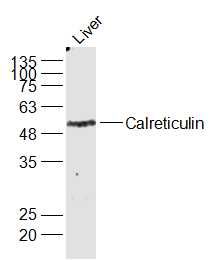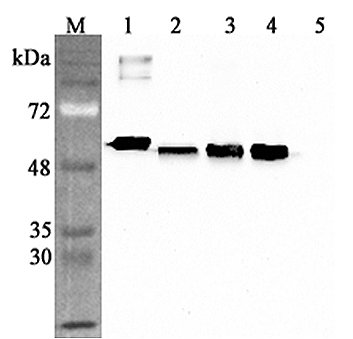Calreticulin antibody
GTX111627
ApplicationsImmunoFluorescence, ImmunoPrecipitation, Western Blot, ImmunoCytoChemistry, ImmunoHistoChemistry, ImmunoHistoChemistry Paraffin
Product group Antibodies
ReactivityBovine, Human, Mouse, Rat
TargetCALR
Overview
- SupplierGeneTex
- Product NameCalreticulin antibody
- Delivery Days Customer9
- Application Supplier NoteWB: 1:500-1:3000. ICC/IF: 1:100-1:1000. IHC-P: 1:100-1:1000. *Optimal dilutions/concentrations should be determined by the researcher.Not tested in other applications.
- ApplicationsImmunoFluorescence, ImmunoPrecipitation, Western Blot, ImmunoCytoChemistry, ImmunoHistoChemistry, ImmunoHistoChemistry Paraffin
- CertificationResearch Use Only
- ClonalityPolyclonal
- Concentration0.2 mg/ml
- ConjugateUnconjugated
- Gene ID811
- Target nameCALR
- Target descriptioncalreticulin
- Target synonymsCALR1, CRT, HEL-S-99n, RO, SSA, cC1qR, calreticulin, CRP55, ERp60, HACBP, Sicca syndrome antigen A (autoantigen Ro; calreticulin), calregulin, endoplasmic reticulum resident protein 60, epididymis secretory sperm binding protein Li 99n, grp60
- HostRabbit
- IsotypeIgG
- Protein IDP27797
- Protein NameCalreticulin
- Scientific DescriptionCalreticulin is a multifunctional protein that acts as a major Ca(2+)-binding (storage) protein in the lumen of the endoplasmic reticulum. It is also found in the nucleus, suggesting that it may have a role in transcription regulation. Calreticulin binds to the synthetic peptide KLGFFKR, which is almost identical to an amino acid sequence in the DNA-binding domain of the superfamily of nuclear receptors. Calreticulin binds to antibodies in certain sera of systemic lupus and Sjogren patients which contain anti-Ro/SSA antibodies, it is highly conserved among species, and it is located in the endoplasmic and sarcoplasmic reticulum where it may bind calcium. The amino terminus of calreticulin interacts with the DNA-binding domain of the glucocorticoid receptor and prevents the receptor from binding to its specific glucocorticoid response element. Calreticulin can inhibit the binding of androgen receptor to its hormone-responsive DNA element and can inhibit androgen receptor and retinoic acid receptor transcriptional activities in vivo, as well as retinoic acid-induced neuronal differentiation. Thus, calreticulin can act as an important modulator of the regulation of gene transcription by nuclear hormone receptors. Systemic lupus erythematosus is associated with increased autoantibody titers against calreticulin but calreticulin is not a Ro/SS-A antigen. Earlier papers referred to calreticulin as an Ro/SS-A antigen but this was later disproven. Increased autoantibody titer against human calreticulin is found in infants with complete congenital heart block of both the IgG and IgM classes. [provided by RefSeq]
- ReactivityBovine, Human, Mouse, Rat
- Storage Instruction-20°C or -80°C,2°C to 8°C
- UNSPSC12352203
References
- Wu SY, Wu HT, Wang YC, et al. Secretory autophagy promotes RAB37-mediated insulin secretion under glucose stimulation both in vitro and in vivo. Autophagy. 2023,19(4):1239-1257. doi: 10.1080/15548627.2022.2123098Read this paper
- Rohwedder A, Knipp S, Roberts LD, et al. Composition of receptor tyrosine kinase-mediated lipid micro-domains controlled by adaptor protein interaction. Sci Rep. 2021,11(1):6160. doi: 10.1038/s41598-021-85578-8Read this paper
- Fucci C, Resnati M, Riva E, et al. The Interaction of the Tumor Suppressor FAM46C with p62 and FNDC3 Proteins Integrates Protein and Secretory Homeostasis. Cell Rep. 2020,32(12):108162. doi: 10.1016/j.celrep.2020.108162Read this paper
- Sikorski K, Mehta A, Inngjerdingen M, et al. A high-throughput pipeline for validation of antibodies. Nat Methods. 2018,15(11):909-912. doi: 10.1038/s41592-018-0179-8Read this paper
- Kuo SM, Chen CJ, Chang SC, et al. Inhibition of Avian Influenza A Virus Replication in Human Cells by Host Restriction Factor TUFM Is Correlated with Autophagy. mBio. 2017,8(3). doi: 10.1128/mBio.00481-17Read this paper
- Huang JH, Ku WC, Chen YC, et al. Dual mechanisms regulate the nucleocytoplasmic localization of human DDX6. Sci Rep. 2017,7:42853. doi: 10.1038/srep42853Read this paper
- Singh N, Johnstone DB, Martin KA, et al. Alterations in nuclear structure promote lupus autoimmunity in a mouse model. Dis Model Mech. 2016,9(8):885-97. doi: 10.1242/dmm.024851Read this paper
- Hulleman JD, Kelly JW. Genetic ablation of N-linked glycosylation reveals two key folding pathways for R345W fibulin-3, a secreted protein associated with retinal degeneration. FASEB J. 2015,29(2):565-75. doi: 10.1096/fj.14-255414Read this paper
- Tang HY, Huang CH, Zhuang YH, et al. EDEM2 and OS-9 are required for ER-associated degradation of non-glycosylated sonic hedgehog. PLoS One. 2014,9(6):e92164. doi: 10.1371/journal.pone.0092164Read this paper
- Law CH, Li JM, Chou HC, et al. Hyaluronic acid-dependent protection in H9C2 cardiomyocytes: a cell model of heart ischemia-reperfusion injury and treatment. Toxicology. 2013,303:54-71. doi: 10.1016/j.tox.2012.11.006Read this paper






